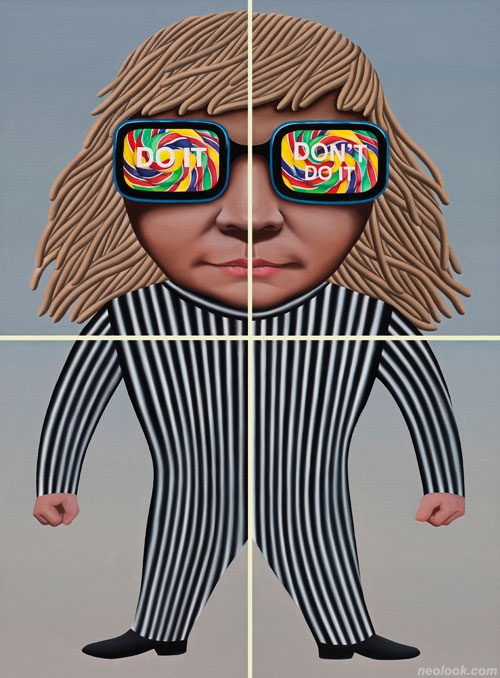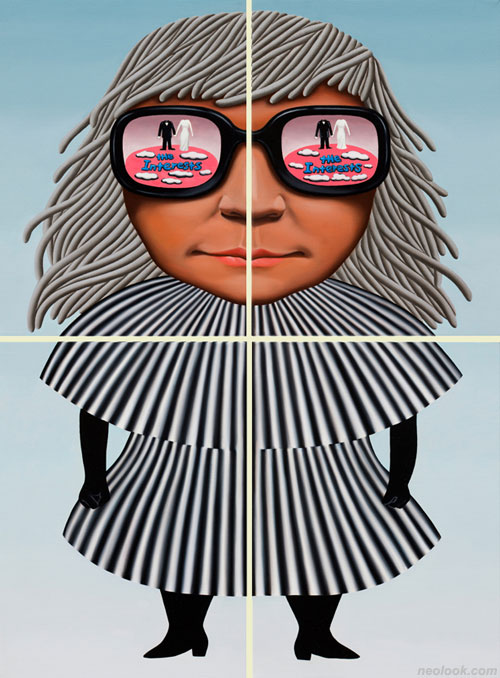- ● homepage
- ● archives
- ● restoration
- ● books
- ● big banners
- ● post board
- ■ neo's search
- ■ about us
- ■ 게재방법 안내
- 개인정보처리방침

- [email protected]
- Tel. 02_335_7922
- Fax. 02_335_7929
- 10:00am~04:30pm
- 월요일~금요일
- 3/3(월) 대체공휴일

Desire
최윤정展 / CHOIYUNJUNG / 崔允禎 / painting 2013_1201 ▶ 2014_0121 / 월요일 휴관
● 위 이미지를 클릭하면 네오룩 아카이브 Vol.20100826d | 최윤정展으로 갑니다.
초대일시 / 2013_1221_토요일_06:00pm
관람시간 / 10:00am~06:00pm / 월요일 휴관
가일미술관 GAIL ART MUSEUM 경기도 가평군 청평면 북한강로 1549(삼회리 609-6번지) Tel. +82.31.584.4722 www.gailart.org
안경이라는 통로 혹은 거울로 본 괄호 속 이미지들 ● 작가 최윤정의 작업에서 나타나는 인물들에는 인위적으로 부각시킨 커다란 안경의 렌즈 속에 익숙한 이미지들이 등장한다. 그 이미지들은 대중매체에 의해 알려지고 인기를 얻게 된 팝스타나 만화의 캐릭터 혹은 상업광고에 의해 알려진 상품과 그와 관련된 전형화된 이미지들이다.

- 최윤정_pop kids #53_캔버스에 유채_91.3×66.8cm_2013
이 이미지들은 너무나 익숙하게 대중들의 시각적 기억 공간을 채우고 있기에 대중들은 거의 무비판적으로 받아들이게 되는데 작가는 바로 이 지점에서 '미디어라는 시각 프레임에 의해 반복적으로 학습되어진 실체가 바로 현대인들의 욕망 아닌가'하는 의심을 갖게 되었던 것으로 보인다. 그리고 바로 이 미디어 환경에서 만나게 되는 일상적 이미지들에 대한 반응을 회화적으로 점검하는 과정에서 자신의 작업에 대한 이야기를 풀어내게 된 것으로 보인다. 즉 현대인들은 보고 싶은 것을 보고 사고 싶은 것을 산다기보다는 보도록 만든 것을 보고 사도록 만든 것을 사는지도 모른다는 이야기이다.

- 최윤정_pop kids #56, #54, #55, #57_캔버스에 유채_각 18×26cm_2013
그런데 작가는 왜 안경이라는 특정한 도구 위에 이러한 이미지들을 올려놓고 이를 정면으로 마주치도록 확대하고 부각시켜 보여주고 있는 것일까? 인간이 세계를 파악하고 자신의 일관된 가치체계 속에서 살아가기 위해서는 자신만의 프레임이 있을 수밖에 없는 것이 사실이다. 이것을 철학자들은 '세계관'이라고 지칭하기도 했지만, 이것은 다시 말하면 인간이라면 누구나 안경과 같이 세계를 보는 프레임을 갖고 있다는 것을 의미한다. 그런데 이 안경이라는 프레임을 통해 세계를 보고 있다는 것을 자각하는 이들도 있지만 자신이 어떤 색의 안경, 또는 어떤 형태의 안경을 갖고 있는지를 자각하지 못하는 이들도 있기 때문에 주관적 시각을 보편적인 것으로 오해하거나 고집하게 되는 경우가 많은 것이라 할 수 있다.

- 최윤정_pop kids #50_캔버스에 유채_91.3×66.8cm_2013
작가 최윤정은 마치 이러한 안경이라는 시각 프레임 자체를 자각하게 하는 거울을 보게 하려는 듯 현대인들의 얼굴위에 안경과 여기에 비춰진 이미지들을 하나의 아이콘처럼 전면에 등장시켜 그려 내고 있다. 여기에 등장하는 어린 아이나 여성 혹은 남성은 현대 문화를 배경으로 각기 다양한 개성을 보여주는 듯하지만 사실 이들은 미디어라는 권력 구조 아래 스테레오타입화 된 상징적 이미지에 불과하며 이 미디어 환경이 만들어준 욕망의 아이콘들일 뿐이라는 것을 작가는 그의 작업을 통해 보여주고자 하는 것 같다.

- 최윤정_pop kids #36_캔버스에 유채_100×100cm_2011
그래서 작가는 현대인의 시각방식을 인물의 표정뿐만 아니라 안경이라는 상징적 물체를 선택하고 이것을 창이라는 프레임으로 변형시키거나 TV나 모니터의 프레임과 유사한 스타일을 그 위에 덧씌워 이 프레임들의 다양한 모습이 하나의 컨텍스트가 되어 욕망적 아이콘들과 마주치게 만드는데, 이때 만들어지는 모호하고 어색한 상황에 관객을 초대하고 있는 것이다. ● 그러므로 작가 최윤정의 작품은 과거 영․미 팝아티스트들에서 거론되는 상품미학에 대한 대안 제시나 소비문화에 편승한 상업주의 미학이라는 코드로 읽기보다는 매스 미디어라는 구조가 만들어낸 현대인의 욕망이라는 실체를 반추해 볼 수 있는 거울과 같은 회화적 장치를 만들어 그 의미를 찾고자 하는 작업으로 읽는 것이 타당하다고 본다. ● 작가는 '표현된 내용의 내러티브가 어떠한 것이냐'라는 것보다는 표현된 형식이 갖고 있는 구조 자체를 통하여 현대인들의 '시각방식' 혹은 '욕망구조'를 드러내 보여주고자 하는 것이며, 이때 매스 미디어적 환경 속에서 조작된 욕망을 상징하는 아이콘의 해석에 대하여는 이미지 자체의 지시적 의미 보다는 그 이미지가 드러나는 조건에 대해 관심을 갖고 있음에 주목할 필요가 있다.

- 최윤정_pop kids #35_캔버스에 유채_150×150cm_2011
최윤정 작가는 시각 프레임과 아이콘이 마주치는 다양한 조합으로부터 발생되는 파생 의미로 관객의 시선을 분산시켜 다양한 해석의 가능성 아래 던져둠으로써 작가 자신은 판단을 유보하되 안경이라는 시각 프레임으로서의 괄호와 내부 이미지의 관계 확장성은 무한히 열어 놓고자 하는 것이다. ● 그래서 그의 작업에서는 안경이라는 프레임이 동일한 세계에 대해 무수히 다른 시각으로 보게 만들 듯 특정한 인물과 그 인물의 안경에 비친 세계라는 두 개의 구조를 동시에 자주 보여주었던 것을 알 수 있는데 이는 그것을 보는 관객으로 하여금 그들의 시각 프레임에 의해 이들의 관계가 자의적으로 해석될 수 있도록 만들고자 하는 의도라고 할 수 있다. ● 결국 작가는 이러한 작업을 통해 사각의 캔바스 위의 그림과 안경에 비친 그림이라는 이중적 구조, 즉 괄호 안의 괄호라는 흥미로운 구조를 관객이 만나도록 하여 그들이 의미의 무한궤도를 옮겨가면서 시각의 괄호적 구조 자체를 경험하도록 만듦으로써 특정한 안경에 의해 걸러진 이미지를 소비하는 대중매체 시대에 있어서 시각에 있어서 프레임이 갖는 구조의 의미와 한계를 관객 스스로 자각 하도록 만드는 것처럼 보인다. ■ 이승훈

- 최윤정_folds #09_캔버스에 유채_72.7×72.7cm_2013
Images in Parentheses, Seen through the Passage or Mirror of Glasses ● In the work of artist Choi Yunjung, familiar images appear in artificially exaggerated large lenses of glasses. The images are those widely known to us through the mass media or those that seem familiar. As the images are so familiar and seem as if they have been filling up the visual memory space of people, the masses accept such information with little criticism. It is at this point that the artist asks the question: "Is the substance repeatedly studied through the visual frames called media in fact the desires of modern humans?" And in the process of examining the reactions of such everyday images encountered in such media environment in a painterly manner, she apparently came to unravel the story of her work. ● Thus, in her work we can often find the artist's views on how people see what they are made to see and buy what they are made to buy, rather than seeing or buying what they want, as well as metaphoric expressions of the situation of today's humans, who are in a chaos of choosing, feeling and thinking based on a sense of déjà vu, as if they saw something before even though it is their first time. ● The images painted by the artist look as if they are manipulated without a filter of self-criticism. They are painted with a feeling of being locked in an artificial form. This is the case of both the figures wearing glasses and the images within the lenses. The two types of images are only divided by the frames of the glasses. Though the images reflected in the glasses and the human figures related to one another through the frame as a boundary, despite the common artificial feeling, they are painted to indicate different layers depending whether they are inside or outside the boundary. ● But why did the artist place such images in a certain tool called glasses, and magnify and exaggerate them before the spectators? It is true that for humans to understand the world and live in their consistent value systems they had to have their own frames. Some philosophers called this "world view," but that is to say, every human being has a frame like glasses to see the world through. Some are aware that they are looking at the world through such "glasses-frames" but some are unaware of what color or what shape of glasses they are wearing. That is why subjective views are often mistaken for universal views and adhered to. ● Artist Choi Yunjung places the glasses and the images reflected upon them on modern humans' faces like icons, as if she were trying to make them realize their rectangular frames and look into the mirror. The young children, women or men appearing in the paintings seem to represent diverse character against the background of contemporary culture, however, they are in fact nothing but stereotypical symbolic images dominated by the power structure of the media, and mere icons of desire made by such media environment. This is what the artist is trying to demonstrate through her works. ● Hence, the artist depicts modern humans' ways of seeing not only through the expressions of the figures, but also by selecting the symbolic object called glasses, and transforming them into frames resembling windows or TV monitors in an attempt to create a single context with the diverse frames, which come face-to-face with the icons of desire. By doing so, Choi is inviting the spectators to the consequent obscure and awkward situation. ● Therefore, it is more reasonable to read Choi Yunjung's works as an attempt to create a mirror-like painterly device to reflect on the substance called desire, which is made by the structure of mass media, rather than as codes representing alternatives for commercial culture commonly referred to in criticism of previous British and American Pop Art, or commercial aesthetics taking advantage of consumer culture. ● The artist wants to reveal the "way of seeing" or "desire structure" of modern humans through the very structure of the form being expressed, rather than "what is the narrative of the contents being expressed," and in this light it is necessary for us to note the conditions under which the images appear, rather than the indicative meaning of the images themselves, in terms of interpretation of the icons symbolizing manipulated desires in the mass media environment. ● By dispersing spectators' views through the significances created from the various combinations of visual frames and icons, and enabling the possibility of diverse interpretation, Choi Yunjung intends to leave the expansive relation of the parentheses, as the visual frames, and the images inside open to infinity, while withholding any judgment herself. ● Thus, it is evident that her works often show two structures simultaneously―a certain figure and the world reflected in that figure's glasses―in the same way they induced innumerable views of a single world through a frame called glasses. The intension was to enable arbitrary interpretation of the relations based on the visual frames of spectators. ● Ultimately, through her works the artist enabled spectators to encounter the interesting dual structure of parentheses within parentheses, or painting on the rectangular canvas and painting reflected in the glasses. By enabling them to experience the visual parentheses structure along the endless track of significance, the artist is inviting them to realize on their own the meanings and limitations of the visual frame in the era of mass media, where people consume images filtered by specific glasses. ■ Lee Seung-Hoon
Vol.20131203c | 최윤정展 / CHOIYUNJUNG / 崔允禎 / painting

